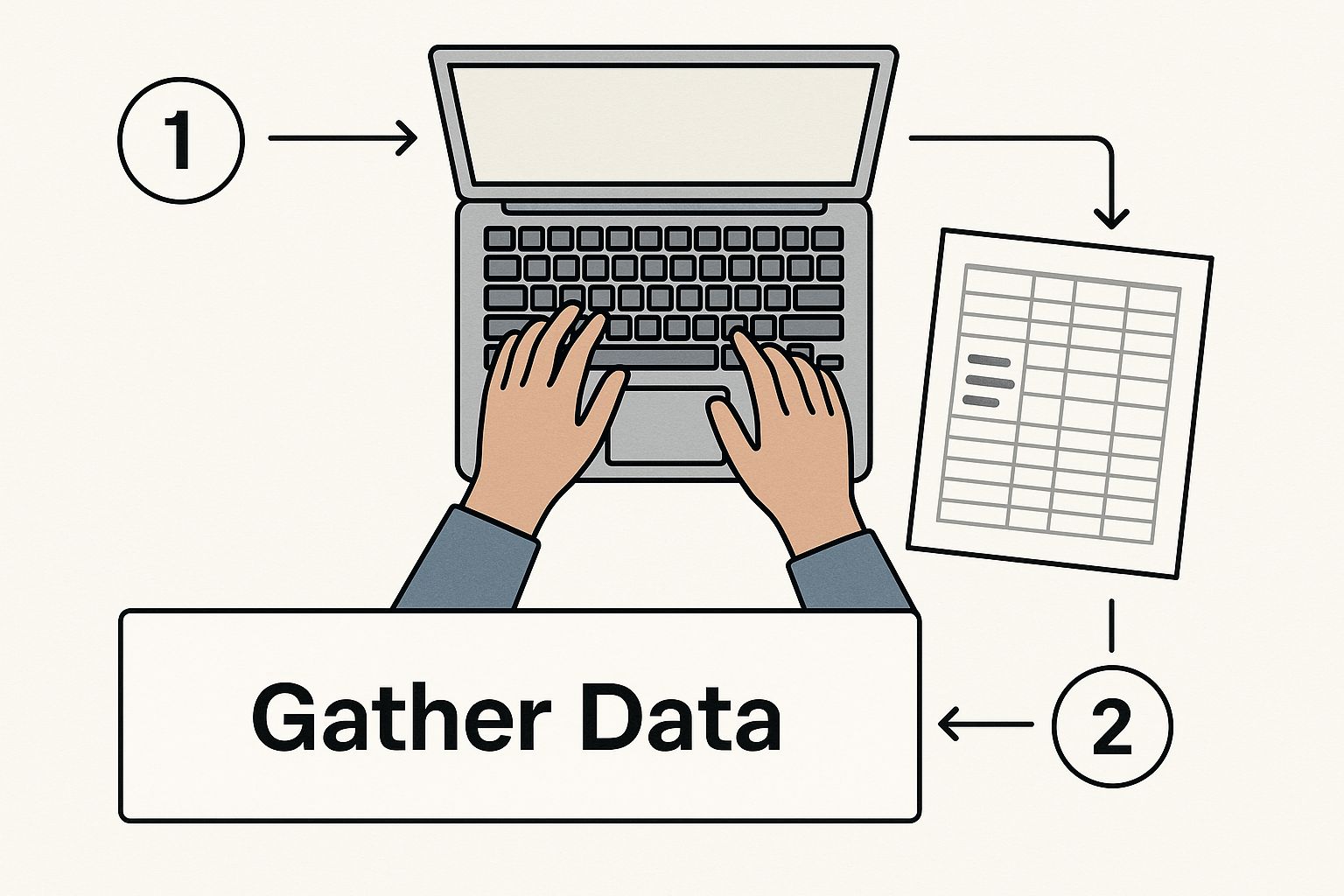Conducting a competitive analysis isn't just a box-ticking exercise. It's about getting a real, honest look at who you're up against, what they're doing well, and—most importantly—where they're dropping the ball. You start by figuring out who your true competitors are, then you dive deep into their products, marketing, and sales tactics to find gaps you can exploit.
Why Competitive Analysis Is Your Secret Weapon
Let's cut through the jargon. At its heart, competitive analysis is about creating a strategic roadmap for your business. It’s a methodical way of looking at your rivals, not just to copy them, but to truly understand why their strategies work and how you can carve out your own unique space. Think of it less like spying and more like smart reconnaissance.
When you do this right, you can see market shifts coming before they happen, sidestep the mistakes everyone else is making, and uncover golden opportunities your competitors have completely missed. It turns analysis from a boring, backward-looking task into a powerful tool that informs every decision you make.
And it's not just a nice-to-have. The market for competitive intelligence is exploding for a reason. It's projected to jump from $6.6 billion in 2025 to over $15.4 billion by 2033. This massive growth underscores just how critical businesses believe this is for staying ahead.
From Copycat to Strategist
A truly effective analysis goes way beyond a simple checklist of features. You need to understand the entire battlefield your business is on.
I always tell people to look for:
- Product & Service Gaps: What customer problems are your competitors just not solving? Your next breakout feature could be hiding right there in their negative reviews.
- Marketing Blind Spots: Are they all-in on Instagram but completely ignoring LinkedIn, where your ideal customers are actually spending their time? That's your chance to own a channel.
- Customer Experience Failures: If you read through their reviews and see endless complaints about slow shipping or unhelpful support, you've just found an area where you can build a reputation for being the best.
The point isn't to just copy the market leader. The real magic happens when you find the strategic openings they've left wide open and build your brand in those gaps. That’s how you turn simple data into a real-world advantage.
Building Your Analysis Framework
To keep from getting overwhelmed, you need a solid framework. A good analysis breaks down your competitors’ operations into a few key areas. To really nail the digital side of things, digging into a comprehensive SEO competitor analysis blueprint can be a game-changer. It gives you a repeatable process for picking apart their online presence.
Here’s a simple table to guide your thinking and make sure you're covering the most critical components.
Core Components of a Competitive Analysis
By systematically working through these areas, you gather the intelligence needed to make smarter moves.
This kind of structured analysis is a foundational piece of a much larger strategy. When you understand your rivals inside and out, you can sharpen your own unique value. For more on connecting these dots, our guide on how branding and market research drive real growth explains how these insights help forge a truly powerful brand.
Ultimately, knowing your competition gives you the confidence to stop reacting to what everyone else is doing and start leading the charge. You'll make faster, better decisions and build a business that's truly built to last.
Defining Your True Competitive Landscape

Before you can size up the competition, you need to be crystal clear on who they actually are. This sounds obvious, but it’s a classic misstep. Too many businesses fixate on the companies that look like a mirror image of themselves, completely overlooking other players fighting for the same customer dollars.
A solid competitive analysis starts with an honest map of your market. Your biggest threat might not be who you think it is. The trick is to think beyond a simple list of companies with the same product. You need to identify everyone who solves the same problem for your customer, even if their solution is totally different.
Direct vs. Indirect Competitors
First things first, let's sort your rivals into a couple of buckets. This helps you focus your energy and understand where the real threats—and opportunities—are coming from.
Direct Competitors: These are the usual suspects. They sell a nearly identical product or service to the same people you do. For a project management tool like Trello, direct competitors are names like Asana or Monday.com. They're playing the same game on the same field.
Indirect Competitors: This is where it gets interesting. These businesses solve the same core problem, but in a completely different way. For Trello, an indirect competitor could be a collaborative doc tool like Notion or even a chat platform like Slack, where teams often end up managing informal tasks.
Ignoring your indirect competitors is a huge strategic blind spot. They can reveal shifts in customer behavior and new market trends long before they become obvious. They help answer the real question: are your customers looking for a better project board, or just a better way to get organized?
Spotting the Giants and the Upstarts
Beyond the direct/indirect split, your market has other characters you need to watch. A complete picture includes both the old guard and the scrappy newcomers.
Think about these two groups:
Legacy Competitors: These are the big, established brands that have been around forever. They have deep pockets, strong reputations, and a loyal customer base. If you're a new design agency like Softriver, a legacy competitor might be a massive, traditional branding firm with decades of history.
Emerging Competitors (Disruptors): These are the new kids on the block, often armed with a clever business model or new tech that could shake things up. For our same design agency, an emerging competitor could be an AI-powered logo generator promising professional designs in minutes for a fraction of the cost.
I’ve found that one of the best ways to spot new competitors is to see who consistently shows up for the keywords you’re trying to rank for. If a company is always beating you in the search results, they are absolutely your competitor, even if their product seems different on the surface.
How to Find Your Real Competitors
Alright, let's get practical. How do you actually unearth all these companies? Simply Googling your product category won't cut it. You have to be a bit of a detective.
Your sales and customer service teams are a goldmine. They're on the front lines every day, hearing exactly which other companies your prospects are evaluating. Just ask them: "When we lose a deal, who are we losing to?" The answers you get are pure gold.
You can also use some clever search tactics. Try Googling things like:
- "
[Your Competitor's Name]vs" to see who they're most often compared against. - "alternatives to
[Your Product]" to find articles and lists that have already done some of the legwork.
Finally, don't forget your own customers. During the onboarding process, make it a point to ask what other tools or services they looked at before choosing you. Their answers give you an unfiltered view of who your audience thinks your competition is—and that’s often the most important perspective of all.
Gathering Meaningful Competitor Intelligence
Once you’ve mapped out your competitive landscape, the real detective work begins. Knowing who to watch is the first hurdle; knowing what to look for is what separates a cluttered spreadsheet from a strategic goldmine. This is where you move from simple awareness to gathering actionable intelligence that can genuinely shape your business decisions.
The goal here isn't to create a mountain of data you'll never touch. Instead, you want to zero in on meaningful information across four critical pillars: product, marketing, sales, and customer experience. Getting this right prevents "analysis paralysis" and ensures every piece of data you collect has a purpose.
I've found the most successful companies focus on five to ten key rivals—the ones with similar products or those chasing the same customer dollars. This focus is what helps uncover real opportunities.
This infographic breaks down the basic flow for gathering competitor data. As you can see, organized data collection is the engine of any effective analysis. It’s about being systematic.
As you can see, organized data collection is the engine of any effective analysis. It’s about being systematic.
Deconstructing Their Product And Tech
First things first, let's look at what they actually sell. A deep dive into your competitor's product or service is absolutely fundamental. Don't just glance at their main features; you need to examine the entire ecosystem they've built around their core offering.
Here's what I recommend digging into:
- Feature Sets and Quality: Go beyond a simple checklist. Sign up for their free trial or, even better, buy their product. How intuitive is it, really? Where are the friction points? Pay attention to the features they're heavily promoting versus the ones that seem neglected.
- Pricing and Value Proposition: Document their pricing tiers, sure, but more importantly, try to understand the value they're assigning to each price point. Are they positioning themselves as the low-cost leader, the premium option, or something in between? Keep an eye out for hidden fees or valuable perks like free shipping.
- The Technology Stack: Knowing what tools they use can reveal a ton about their operational priorities and technical capabilities. Use tools like BuiltWith or Wappalyzer to see what's under the hood of their website. Are they using advanced analytics? A specific CRM? This can hint at their level of business maturity.
For industries like e-commerce, getting granular pricing and product data is key. Learning how to scrape e-commerce data for a competitive edge can give you a massive advantage here.
Analyzing Their Marketing And Sales Playbook
How your competitors attract and convert customers is a treasure trove of insights. You can learn from their wins and, just as importantly, from their mistakes. This is often where you'll find gaps in the market just waiting for your brand to fill them.
A thorough analysis means looking at their entire funnel, from top-of-funnel brand awareness to their bottom-of-funnel sales tactics. You need to get a feel for their messaging, the channels they live on, and how they guide prospects toward a purchase.
Of course, this all starts with knowing who they're trying to reach. If you're still working on defining your own customer base, our guide on how to find your target audience in 5 steps is a great place to start.
My best tip: Become their customer. Seriously. Sign up for their newsletter, follow them on social media, and even walk through their sales process. You’ll experience their entire funnel firsthand, giving you an unfiltered view that raw data alone can never provide.
Here’s a practical checklist:
- Content and SEO Strategy: What topics are they writing about on their blog? Use an SEO tool to see which keywords they rank for. This tells you exactly what problems they're solving for their audience and where they’re winning the search battle.
- Social Media Presence: Don't just count followers. That's a vanity metric. Instead, analyze their engagement. What kind of content actually gets likes, comments, and shares? What's the general sentiment in the comments section? This is a direct line into what resonates with their (and potentially your) audience.
- Paid Advertising: Tools like the Meta Ad Library and Google's Ads Transparency Center are fantastic for legally spying on the ads your competitors are running. Pay close attention to their messaging, their offers, and the landing pages they're sending traffic to.
Tapping Into The Voice Of The Customer
Honestly, your competitor’s customers are your single greatest source of intelligence. Their public feedback provides raw, unfiltered truths about where a competitor shines and, more importantly, where they consistently fall short.
Customer reviews aren't just for gauging sentiment; they're a direct line into what the market truly needs and wants. Look for patterns in what people praise and, especially, what they complain about.
- Review Websites: Scour sites like G2, Capterra, Trustpilot, and Yelp. A pro tip is to filter reviews by "lowest rating" to quickly spot recurring problems. Is their customer support notoriously slow? Is a key feature always buggy? These are your opportunities.
- Social Media and Forums: Search for mentions of your competitor on platforms like X (formerly Twitter), Reddit, and industry-specific forums. People are often much more candid and share frustrations more freely in these less formal settings. I also recommend setting up Google Alerts for your competitors' brand names to get these insights in real-time.
This feedback loop is invaluable. If dozens of customers complain that Competitor X’s product is a nightmare to set up, you can make "effortless onboarding" a core part of your own messaging and product design. Just like that, their biggest weakness becomes your strategic strength.
Turning Data Into a Winning Strategy

All that data you just collected? It's just a pile of numbers until you figure out what it all means. This is the moment where raw information becomes real-world wisdom. The magic isn't in the data itself—it’s in connecting the dots to answer the only question that matters: "So what?"
This is where you switch hats from a data collector to a strategist. You're searching for the story hidden within the stats. Your mission is to spot patterns, recognize threats before they become major problems, and, most importantly, find those golden opportunities your business is built to seize.
From Numbers to Narratives
Think like a detective. Every bit of data you have—a bad review, a top-ranking keyword, a competitor's pricing model—is a clue. Your job is to piece these clues together to paint a clear picture of your competitor's playbook and expose its weak spots.
A great starting point is to benchmark your performance directly against your top rivals. It's a simple side-by-side comparison across key areas of the business. Honestly, this is the core of any good competitive analysis, because it gives you hard numbers to see where they’re strong, where they’re fumbling, and how they’re positioned in the market.
By 2025, expect to see even more focus on metrics like market share percentage, customer engagement, pricing, product quality, and even operational details like delivery times. For a deeper dive, check out this guide on using competitive analysis metrics from invespcro.com.
Spotting Your Strategic Openings
Once you start benchmarking, the patterns will jump right out at you. These patterns are your road signs, pointing directly to strategic openings. You're not just looking for data; you're looking for leverage.
Here are the kinds of actionable insights you should be on the hunt for:
- Gaps in Customer Experience: You find that Competitor X has a 2-star average for customer support on G2, with reviews constantly complaining about slow responses. Bingo. That’s your chance to make "24/7 expert support" a central part of your marketing.
- Blind Spots in Product Features: You analyze five competitors and realize they're all chasing complex, enterprise-level features. Meanwhile, their forums are filled with small business owners begging for a simpler, cheaper version. That's a wide-open market gap. You can create a product built just for them.
- Opportunities in Content and SEO: Your biggest rival ranks for valuable keywords, but you notice their articles are thin and haven't been updated in years. That's a clear shot. You can develop far better, more in-depth content to steal their spot in the search results.
The real breakthroughs happen when you combine different data points. A competitor's high price might look like a strength, but when you pair it with reviews complaining about a lack of features, their "premium" product suddenly looks overpriced.
This level of thinking is what separates market leaders from followers. In my own work, I'm constantly watching how other agencies position themselves. If I see everyone chasing big corporate rebrands, I'll double down on messaging that speaks to startups who need speed and affordability—a market the big players often ignore.
Key Metrics for Competitor Benchmarking
To do this right, you need to track the right things. A messy spreadsheet just creates confusion. Instead, organize what you find into clear categories so you can see, at a glance, who’s winning where.
This table gives you a simple framework for tracking the metrics that actually matter.
Using a structured approach like this keeps you from getting lost in the details and focuses your analysis on what actually moves the needle. Every empty cell or low score in your competitor's column is a potential win for you. This isn't about finding fault; it's about finding opportunity.
Turning Your Competitive Analysis Into Action
A competitive analysis collecting digital dust in a spreadsheet is a massive waste of effort. All that research, all that data, all that insight—it all funnels down to this one critical moment: actually doing something with it. This is where you turn what you’ve learned into real-world actions that give your business a measurable advantage.
Ultimately, the whole point is to translate raw data into smarter business decisions, especially when it comes to things like developing powerful customer acquisition strategies for growth. It’s about making confident, data-backed choices in every corner of your company.
From Insights to Initiatives
Your analysis has essentially handed you a playbook of your competitors' strengths and, more importantly, their weaknesses. Now, it's time to put that knowledge to work. You can use these findings to directly shape and sharpen your own strategies, from the products you build to the marketing messages you broadcast.
Here’s how this might look in the real world:
- Refining Your Product Roadmap: Let's say your research shows that your top three competitors all lack a key software integration. You've seen customers practically begging for it in online reviews. Boom. That insight goes straight to your product team with a clear recommendation: prioritize building that integration.
- Adjusting Your Pricing Strategy: You discover a competitor successfully carved out a niche with a lower-priced, feature-light tier for budget-conscious customers. This could be your lightbulb moment to create a similar entry-level plan to attract a new audience without undercutting your core offerings.
- Optimizing Your Marketing Campaigns: You notice a rival’s ads are all about technical specs, but their customer reviews rave about their amazing support. That’s your opening. You can launch a new campaign that hammers home your own brand's superior, human-centered customer service.
How to Prioritize Your Next Moves
You’re going to have a long list of ideas. You can't tackle everything at once, and you shouldn't even try. This is where you need to get strategic.
A simple but incredibly effective tool I always recommend is the Impact/Effort Matrix.
The concept is easy. You plot every potential action on a four-quadrant grid:
- High-Impact, Low-Effort (Quick Wins): These are your no-brainers. Start here. Think updating your website copy to target a valuable keyword your competitor is totally ignoring.
- High-Impact, High-Effort (Major Projects): These are the big, strategic bets. They require serious resources—like developing a major new product feature—but promise a huge return.
- Low-Impact, Low-Effort (Fill-Ins): These are the “nice-to-haves.” You can chip away at them when you have downtime, but don’t let them distract you from the bigger goals.
- Low-Impact, High-Effort (Time Sinks): Avoid these like the plague. They burn through time and money with very little to show for it.
This simple framework forces you to be brutally honest about your resources. It turns a messy, overwhelming to-do list into a clear, strategic roadmap for getting things done.
Make Analysis an Ongoing Habit, Not a One-Time Project
The best companies I've worked with get this: competitive analysis isn't a project you check off a list. Markets change, new players pop up out of nowhere, and what customers want today might not be what they want tomorrow. Your analysis has to be a living, breathing part of your strategy.
Set a recurring date in your calendar to refresh your data. For most businesses, a quarterly review is a great rhythm. It allows you to track how competitors are evolving, spot emerging trends, and continuously tweak your own game plan.
For small businesses trying to punch above their weight, consistently applying these learnings is one of the most effective branding tips for small business success.
By making competitive analysis a continuous loop of Research > Analyze > Act > Repeat, you stop being reactive. You start anticipating market moves, keeping your brand agile, informed, and always a step ahead.
A Few Final Pointers on Competitive Analysis
Even with a solid plan, a few questions always seem to come up once you start digging into the data. Let's tackle some of the most common ones I hear from teams just getting started. Think of this as a quick chat to clear up any lingering uncertainties before you dive in.
How Often Should I Really Be Doing This?
One of the biggest mistakes I see is treating competitive analysis as a one-and-done project. Your market is always in motion—new competitors show up, old ones pivot, and customer tastes change. Your analysis has to keep pace.
For most businesses, a thorough, deep-dive analysis once a quarter is the right rhythm. It’s frequent enough to spot meaningful trends before they become major problems, but not so often that it feels like a constant burden.
However, if you're in a lightning-fast industry like consumer electronics or a trend-driven field like fashion, you might need to do a quicker check-in every month. The goal isn't to follow a rigid schedule but to build a consistent habit.
Think of it like a regular health check-up for your business. You don't need to run a full diagnostic every single day, but consistent monitoring helps you catch issues early and stay ahead of any surprises.
What if I’m Working With a Tiny Team or Budget?
Don't let a small team or a tight budget stop you. You absolutely do not need a massive intelligence department or a suite of expensive tools to get powerful insights. The key is to be scrappy and smart.
Focus your energy on high-impact activities that cost little to nothing. Some of the best information is hiding in plain sight, completely free to access:
- Customer Reviews: Dive into sites like G2, Trustpilot, or even Google Reviews. This is where you'll hear what real customers love and hate about your competition.
- Social Media Eavesdropping: Follow your rivals. Read the comments on their posts. It’s a goldmine for understanding how their brand is perceived in the wild.
- Become a Customer: Sign up for their newsletter, read their blog, and go through their checkout process. It costs you nothing but time and gives you a firsthand look at their customer experience.
Be strategic. Instead of trying to track 20 different companies, laser-focus on your top three to five. You’ll get far more value by going deep on a few key competitors than by going wide and shallow on everyone.
Are There Any Ethical Lines I Shouldn’t Cross?
Absolutely, and this is non-negotiable. There's a massive difference between smart, strategic research and shady corporate espionage. Your brand's integrity is on the line.
The rule of thumb is simple: stick to information that is publicly available or ethically obtained. If any customer could find it, it's fair game.
Here’s a clear breakdown of what’s okay and what’s not:
My personal test is this: if you wouldn't be comfortable explaining your methods to a journalist on the record, you shouldn't be doing it. It’s that simple.
Ready to build a brand that stands out from the competition? At Softriver, we specialize in creating custom brand identities that capture your unique value. Our expert designers turn competitive insights into a visual strategy that positions you to win. Get your professional brand identity in just 48 hours.







